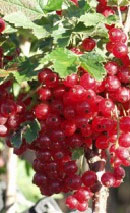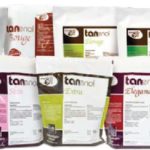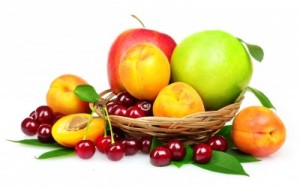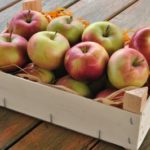Produkt wyjściowy — dojrzały owoc

O ile we wstępie była mowa o winie jako elemencie „dóbr kultury”, używce lub składniku pożywienia, jakby było ono gotowym produktem naturalnym, o tyle w ostatnim zdaniu zwróciłem uwagę na to, że wino należy przede wszystkim sporządzać z pomocą sił natury. Wino jest przefermentowanym sokiem z odpowiednich owoców. Jest to szczególnie ważne, bo w gruncie rzeczy ze wszystkiego, co rośnie, da się wycisnąć sok i każdy sok – przy odrobinie zabiegów – można poddać fermentacji. Ograniczymy się tylko do soku gronowego i owocowego, wspominając jedynie przy okazji o kilku bardziej „egzotycznych” możliwościach sporządzania wina, nawet jeśli zdarzają się zaprzysiężeni zwolennicy wina z grzybów lub warzyw kapustnych.
Niewiele gatunków owoców nadaje się na surowiec do wyrobu dobrego i zdrowego wina. Chcę przez to powiedzieć, że jakość wina zależy od harmonijnie dobranych proporcji cukru, kwasu i ekstraktu, od przebiegającego bez zakłóceń procesu sporządzania wina i jego leżakowania oraz od (względnej) odporności wina na choroby. Będzie o tym jeszcze mowa, ponieważ każdy gatunek owoców inaczej reaguje na proces fermentacji i daje bardzo różne rezultaty. Dlatego też nie chcemy się tu zajmować sokami z warzyw – od pomidorów do marchewki – bo są one godne polecenia jako soki, ale nie jako wina.
Ten, kto posiada własny ogród albo zajmuje się zbiorem owoców, czy będą to dzikie, czy szlachetne odmiany jabłoni przy starych wiejskich drogach, ten z pewnością zbierze to, co natura daje w obfitości: podstawowe gatunki jabłek i gruszek oraz najróżniejsze odmiany jagód.
Najczęściej nie ma kłopotu ze spożytkowaniem corocznych darów natury. Jeśli owoce występują w dostatecznej ilości, to oczywiste, że można je wekować, pasteryzować, marynować lub suszyć, ale również można je przerobić na sok i wino. Kto zebrał o cetnar za dużo jabłek lub innych owoców, nie będzie się zastanawiał, czy dany gatunek najlepiej nadaje się do wyrobu wina, lecz spróbuje zrobić z nich jak najlepszy użytek. Kto zna swój ogród i jego plony, wie zresztą z doświadczenia, jakie surowce w jaki sposób najlepiej wykorzystać. Przyrządzając marmolady i galaretki zwraca się głównie uwagę na to, aby owoce, z których się je robi, miały same w sobie zdolność do żelowania. Natomiast na wina i soki wybiera się takie gatunki owoców i jagód, które nie zawierają składników żelujących (jeśli jednak tak się dzieje, można temu zaradzić przez użycie środków chemicznych).
Zbiór owoców
Ważnym etapem sporządzania soków i win jest zbiór w pełni dojrzałych owoców. Jego właściwy termin najlepiej ustali sam ogrodnik na podstawie własnego doświadczenia. Dojrzewanie owoców zależy bowiem od użytej do szczepienia rośliny podkładki, od klimatu panującego w danym regionie, od pogody w okresie dojrzewania, od położenia ogrodu i wreszcie od rodzaju gleby. Nie sposób dokładnie zmierzyć, jak duży jest wpływ poszczególnych czynników. Ja także na podstawie obserwacji drzew i krzewów każdego roku o innej porze stwierdzam: „Już nadszedł czas”.
Nie potrafię zatem w chwili obecnej stworzyć ogólnie obowiązującego kalendarza zbiorów i nie chciałbym też sprawy terminu zbiorów podnosić do rangi problemu. Doświadczony rolnik zna kilka żelaznych reguł, których należy się trzymać.
• Pierwszą oznaką dojrzałości są spady – opadające owoce, które coraz gęściej ścielą się na ziemi wokół drzewa. Spady są to zaatakowane przez szkodniki owoce, które dojrzewają wcześniej „z konieczności”.
• Jeśli przy zrywaniu owocu z drzewka szypułka daje się odłamać bez wysiłku, to znaczy, że owoc osiągnął pełną dojrzałość.
• Jeżeli po przekrojeniu owocu, na przykład jabłka, okaże się, że pestki już zbrązowiały, należy zacząć przygotowywać urządzenia do sporządzania soku.
Są to jedynie wskazówki dotyczące owoców rosnących na drzewach, nie mają one zastosowania do owoców jagodowych.
Rozmaite odmiany owoców mogą osiągnąć różne stopnie dojrzałości. O dojrzałości owoców pestkowych (węgierki, mirabelki i inne) można mówić, gdy są zdatne do spożycia. Ich stopień dojrzałości można poznać po tym, że stają się miękkie, słodkie, a pestka daje się łatwo oddzielić od miąższu. Po osiągnięciu dojrzałości do spożycia kończy się w owocach pestkowych chemiczny proces wytwarzania cukru. Natomiast owoce ziarnkowe (jabłka, gruszki i inne), które są przeznaczone do produkcji soków i win, muszą osiągnąć dojrzałość podczas leżakowania. To znaczy, że owoce te po zbiorach nadal dojrzewają i wytwarzają cukier, aż osiągną pełną wartość. Jeżeli owoce pozostawi się ich własnemu losowi i pominie się okres dojrzewania podczas leżakowania, staną się „ciastowate”, tracąc przy tym na zawartości cukru, pomarszczą się i zeschną lub zgniją.
Wszystkie owoce zebrane zbyt wcześnie lub zbyt późno mają niewielką wartość albo w ogóle nie nadają się do użytku. Bardzo się myli ten, kto sądzi, że wszystkie owoce nadają się do sporządzania soków i win, bo można je w końcu dosłodzić. Kubki smakowe znacznie wcześniej rejestrują różnice jakości w przypadku spożywania soków i win niż podczas jedzenia galaretek i dżemów. „Z niedojrzałych i przejrzałych, z zepsutych i chorych winogron nie da się zrobić dobrego wina”. – To stare winiarskie powiedzenie można z powodzeniem zastosować do soków i win z innych owoców.
Ale doskonały smak napoju zależy nie tylko od dobrej jakości owoców. Z jakością surowca wiąże się także skłonność do utraty smaku, zmiana wyglądu (zmętnienie – zmiana barwy) oraz podatność na choroby. Dlatego też do sporządzania soków i win należy używać jedynie w pełni dojrzałych owoców (dojrzałych do spożycia bądź też dojrzałych w czasie leżakowania).
Niedojrzałe owoce nie mają odpowiedniego aromatu i zawierają zbyt mało cukru, a za dużo kwasu i substancji żelujących, które utrudniają lub nawet uniemożliwiają później klarowanie wina.
Niedostateczną ilość cukru i nadmiar kwasu można wyrównać jedynie środkami chemicznymi (dodatek cukru, zmniejszenie zawartości kwasu), a słaby aromat, który później tworzy „bukiet” wina, staje się przez to jeszcze słabszy. Pełna dojrzałość winogron, jagód czy innych owoców to specjalna wartość i nie da się jej zastąpić w sztuczny sposób, czy to przez stosowanie środków chemicznych, czy jakieś kiperskie sztuczki.




